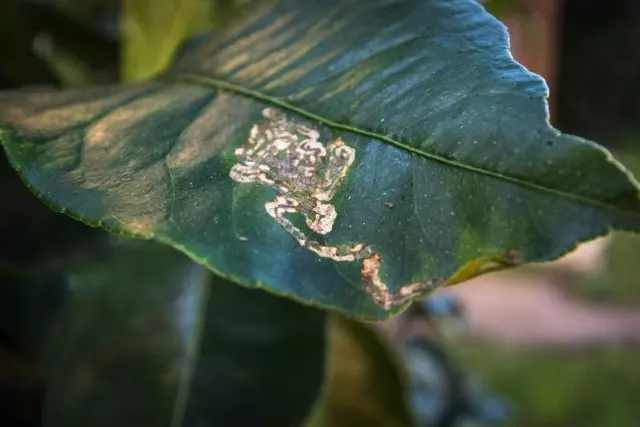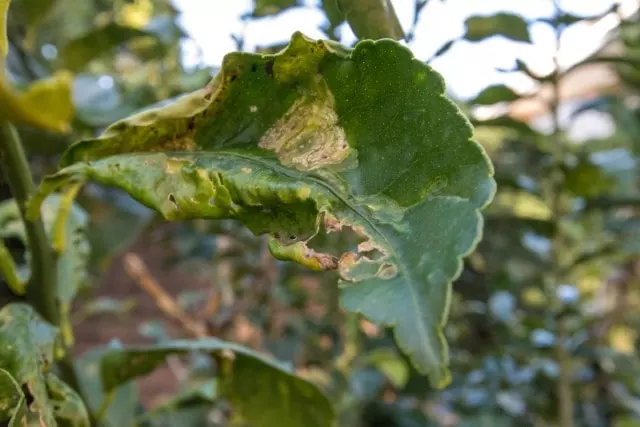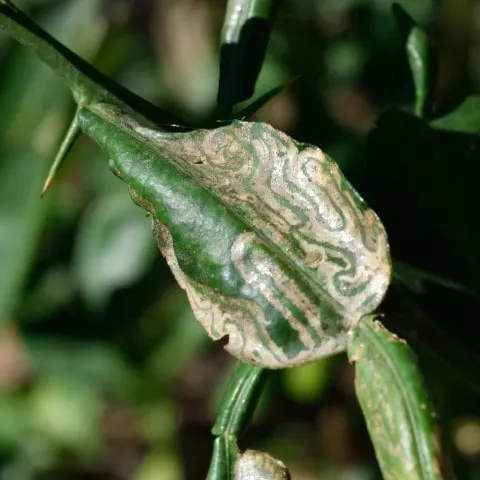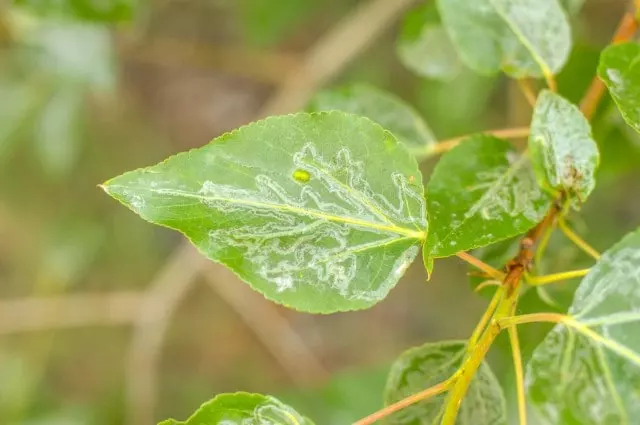If you don’t fight the leafminer in time, it can give you a big headache. To the point of infecting your entire garden. But from today, the leafminer will not be a problem for you. Learn all about how to get rid of citrus leafminer organically in this article.
Surely, if you want to know about the leafminer pest, it is because your plants are suffering from it, or you need to know more information about citrus leafminer.
If so… DON’T WORRY!
You’ve come to the right place. Because, besides giving you all the information you need to know to fight it, we are going to tell you the method we use to save time, effort, and money.
Sounds great, doesn’t it?
We’re not going to hold anything back. We’re going to explain EVERYTHING simply so that by the time you finish reading, you can start taking care of your fruit trees. Continue reading to learn more about citrus leafminer treatment.
Table of Contents
What Is the Citrus Leafminer?
What is the Citrus Leafminer? This is the first question you should ask yourself to find a method to eliminate citrus leafminer. The citrus leafminer insect (technically called: micro lepidopteran) is a small moth that lays its eggs on the leaves of fruit trees.
From these eggs hatches a transparent larva, which is the one that produces the “evidence” that we can see on the leaves that suffer from it. As it feeds on the leaf, it leaves a groove. And the larva turns from transparent to dark brown until it reaches its adult age.
Finally, it changes its appearance to a silvery gray, making it difficult to differentiate males from females. As adults, the citrus leafminer is about 0.12″ (3 mm) long.
What Plants and Trees Citrus Leafminer Attack?
The main source of food for their young is the leaves of trees and plants. This means that citrus leafminers can affect any plant or tree. But evidence shows that most of the time, citrus trees such as lemon or orange are their favorite.

How Does the Citrus Leafminer Spread?
Once the citrus leafminer has reached adulthood and become a moth, it seeks out a newly forming leaf to lay its eggs. The eggs, which have a transparent appearance, hatch into caterpillars after 10 to 15 days.
Upon hatching, the caterpillar settles beneath the outer layer of the leaf to feed. Once the larva matures, it removes silk threads, which it will use to create a pupal chamber. As the threads dry, they cause the leaf to roll upon itself, which eventually covers the larva and protects it from predators.
Once the metamorphosis is complete and the moth has become a moth, it goes in search of new shoots or tender leaves to repeat the reproductive cycle.
What Are the Symptoms Caused by Citrus Leafminers?
The symptoms suffered by citrus trees are noticeable to the eye. The citrus leafminer usually attacks the leaves, so the first place to look is there. If it is possible to observe well, it is possible to appreciate in the infected trees, some small grooves that are visible to the naked eye. You can also find eaten leaves on the lemon tree.
If a leaf is badly affected, we will see that it tends to deform and dry out. We will likely find leaves both on the ground and on the lemon tree.

What Are the Consequences of NOT Eliminating the Citrus Leafminer?
By attacking directly on the leaves, it is being directly affected, since these are the “lungs” of the plant. If you do not prevent it, the leafminer will end up eating the leaf. This leads to the leaf drying out and falling off prematurely.
This is very detrimental to the lemon tree, as it does not give it enough time to regenerate new leaves. If the leafminer ends up eating a large part of the leaves of the lemon tree, it may not be able to get the necessary nutrients from photosynthesis and will eventually die.

How to Get Rid of Citrus Leafminer Organically and Chemical
When we think about how to combat the citrus leafminer and look for the best treatments, it is complicated to find the “best” one. Since the treatment will depend largely on factors such as the season in which it is occurring, how old the lemon tree is, what percentage of the tree is infected, and many others.
But the most important factor that will determine the possible treatment is the percentage of the lemon tree affected by the leafminer. As a general rule, the higher the percentage of infestation, the more aggressive our lemon tree will have to be. You should keep this in mind, especially if your lemon tree is young.
We will now mention the different citrus leafminer treatments against the leafminer that can be chosen. These will go from less to more aggressive for the lemon tree.
Citrus Leaf Miner Organic Treatment
When choosing a method how to get rid of citrus leafminer, the most favorable for the lemon tree is the biological or organic method. As the name implies, this method is one in which nature itself will take care of eliminating the pest. The objective of this treatment is to prevent the lemon tree from suffering as little as possible.
The best time to use this method is when citrus leafminer buds are just emerging on the leaves and there is a relatively little infected percentage of the lemon tree. In this way, you can effectively and naturally get rid of the pest without damaging your tree.
In some cases, they can be eliminated without human intervention, where the same insects or other animal species, such as birds, are responsible for eliminating this pest.
On the other hand, we can intervene by placing in our lemon tree parasitoids that feed on the leaf miner. In this way, we are encouraging the elimination of the leaf miner in a “natural” way, as it would normally happen in nature.
Some of these species are Thrips sp, Chrysoperla carnea, Orius sp, and some spiders. In case you want to use any of these predators to combat the citrus leafminer in your lemon tree, we recommend that you consult with nurseries or with some experts since the lack of control of them can create other problems.
The Cultural Control Method
This treatment is more oriented to prepare a more favorable environment for crops. In which the use of regulated fertilizers, controlled pruning, and irrigation is encouraged. In this way, to be able to focus on obtaining uniform shoots of high quality but in small quantities. This way you can have control of the pest in the case of contracting it.
For this case, we are not going to give too much importance because, to obtain this type of yield, studies and analyses are needed that only growers who are dedicated to citrus production can justify. Learn more about how to prune lemon Meyer tree.
The Chemical Control Method
In this type of treatment, we will use insecticides to eliminate the citrus leafminer. It must be kept in mind that this type of treatment is very aggressive for the tree, so its use must be justified. We recommend using this method when the lemon tree is more than 70% infested.
The best time to make an application is in the summer. The place where we should apply the chemical is especially in the buds that contain flowers and fruits that reach between 1.2″ to 2.4″ (3 to 6 cm) long.
Although not everything ends with a couple of applications per week. It is necessary to do a constant follow-up. Because today you can be eliminating the leafminer from the existing shoots, but the pest can continue to develop in those leaves that will appear after the treatment.
Many chemicals can be applied, and each one has its specific application. Among them, we can find Abamectin, Lufenuron, Benfuracarb, Carbosulfan, Methyl Pirimiphos, Hexaflumoron, Flurenoxuron, and Diflubenzuron.
- INSECT KILLER: Kills listed insects that damage fruit and citrus trees, including aphids, whiteflies, Asian citrus psyllids, thrips, citrus leafminers and leafhoppers
- 2 MONTH PROTECTION: Prevents new infestations for up to 2 months
- NO SPRAYING: Just mix and pour concentrate at base of plants
We recommend that in case you need to use any of these chemicals, you should first consult a specialized nursery for advice on the one that best suits your situation.
How to Get Rid of Citrus Leafminer Organically with Neem Oil
This method is very simple and consists of small steps that you will not even need to write it down because it is easy to remember.
It consists of preparing a mixture that we will tell you later what is composed of, and we will use it to spray the lemon tree.
Nothing more than this.
You will only have to repeat this spraying every 7 days until the new shoots start to come out without wrinkles.
When you start to notice this, it will mean that you have ERADICATED THE PEST FROM YOUR LEMON TREE.
It’s as simple as that, as you are reading.
What is the liquid made of?
To prepare this mixture, you will only need 3 ingredients that will be essential to eliminate the pest.
- POTASSIUM SOAP (Order here).
- NEEM OIL (Order here).
- WATER
To prepare 1.2 Gallon (1 liter) of the mixture, we will use :
- 1 teaspoon (5 grams) of potassium soap
- 0.16 oz (5 ml) of neem oil
To learn more about neem oil, we leave you two previous articles. How to mix neem oil for plants and how to apply neem oil to plants.

How To Prevent a New Outbreak of The Leafminer or Phyllocnistis Citrella?
After eliminating the citrus leafminer from your lemon tree, we recommend that you use the preparation mentioned above, at least every 15 days.
What we want is to prevent the new shoots that are coming out from getting this pest again. Ideally, every 15 days, after eliminating the pest, you should apply the mixture until the next winter.
This is because the periods from spring to autumn are the worst months for lemon trees. The right environment is already created for this pest to infect your lemon tree again.


